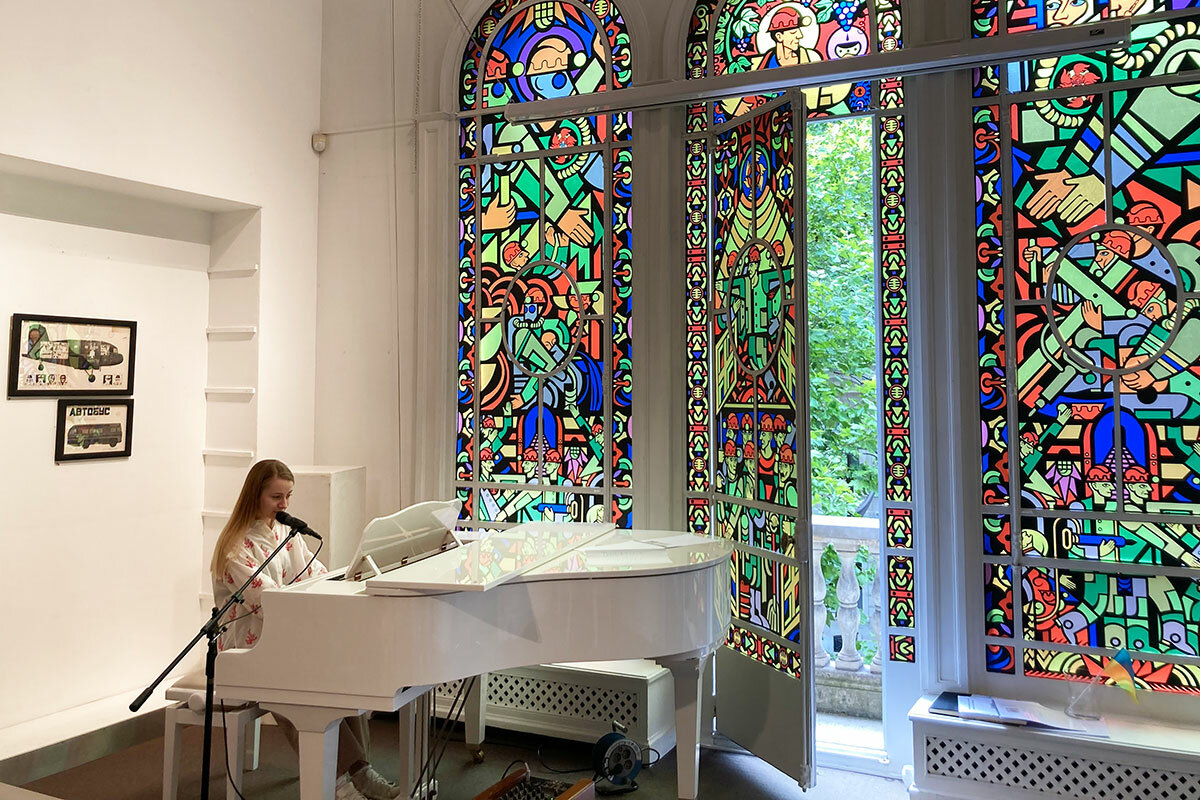Safe in Paris, Ukrainian artists try to inspire French compassion amid war
Loading...
| Paris
Innumerable Ukrainian artists and cultural figures have found themselves in exile in France since the Russian invasion began on Feb. 24. They join the nearly 100,000 Ukrainian refugees currently in France and the more than 5 million across Europe.
As the war continues into its fifth month, Ukrainian President Volodymyr Zelenskyy has expressed concern that the world is experiencing “Ukraine fatigue,” telling Canadian students at the end of June, “Don’t forget about what’s happening in Ukraine.”
Why We Wrote This
A story focused onBy providing a safe haven for Ukrainian artists, France is offering them a feeling of home while also creating a connection between the French public and some of Ukraine’s prized cultural offerings.
Art has been one way of humanizing the conflict, as more Ukrainian artists flee home and continue their craft in exile. The effect of their art has been twofold. For artists, making and sharing their work has been a way to channel difficult emotions surrounding the war. For the French public, experiencing Ukrainian art and culture has put a personal face on the war and built compassion for a resolutely independent Ukraine.
“You can’t just keep showing the same images of war on the news,” says Viktoriia Gulenko of the Cultural Center of Ukraine in France. “Our goal is to show a positive image of Ukraine and open up our cultural traditions to the French, in order to build a lasting link between people.”
Kristina Kadashevych sails into the air in a pale blue leotard, legs outstretched in a leap. As her feathery frame floats back to the ground, her fellow company members stand in position, arms raised delicately overhead.
This is just a rehearsal for the Kiev City Ballet, whose 38-member-strong company has been in exile in France since arriving for a national tour just as the war in Ukraine began. But Ms. Kadashevych says that every time she performs for a live audience, she is overcome with emotions.
She’s from the eastern city of Zaporizhzhia, whose nuclear power plant was taken over by Russians in March. It was around then that her family fled to the west of Ukraine, and she decided to leave her parents and 3-year-old son to join the Kiev City Ballet in Paris.
Why We Wrote This
A story focused onBy providing a safe haven for Ukrainian artists, France is offering them a feeling of home while also creating a connection between the French public and some of Ukraine’s prized cultural offerings.
“It’s horrible to be away from my son, but I needed to work,” says Ms. Kadashevych, after a rehearsal at the Théâtre du Châtelet, where City Hall has lent the dancers practice space. “In some ways, dancing helps me to stop thinking about [the war]. When you’re dancing, you only think about dancing. But when I see people waving Ukrainian flags at the end of a show, every time I begin to cry.”
Dancers from the Kiev City Ballet are just some of the innumerable artists and cultural figures who have either fled Ukraine or found themselves in exile in France since the Russian invasion began on Feb. 24. They join the nearly 100,000 Ukrainian refugees currently in France and the more than 5 million across Europe.
As the war continues into its fifth month, Ukrainian President Volodymyr Zelenskyy has expressed concern that the world is experiencing “Ukraine fatigue,” telling Canadian students at the end of June, “Don’t forget about what’s happening in Ukraine.”
Art has been one way of humanizing the conflict, as more Ukrainian artists flee home and continue their craft in exile. The effect of their art has been twofold. For artists, making and sharing their work has been a way to channel difficult emotions surrounding the war. For the French public, experiencing Ukrainian art and culture has put a personal face on the war and built compassion for a resolutely independent Ukraine.
“You can’t just keep showing the same images of war on the news. After a while, people get tired and they don’t respond to it anymore,” says Viktoriia Gulenko, the director of the Cultural Center of Ukraine in France, which has held numerous events in the last months.
“Our goal is to show a positive image of Ukraine and open up our cultural traditions to the French, in order to build a lasting link between people. It’s only by way of culture that we can achieve this.”
“Being here is like connecting the dots”
Around 20 women – a mix of French and Ukrainian – are seated around a long card table, bent over their wooden spoons and paint palettes. Olena Shaposhnyk, a professional artist who arrived from the city of Dnipro three months ago, moves around the table in a vibrant blue blazer, stopping sporadically to give instructions.
This workshop at Paris’ Cultural Center of Ukraine is on the traditional Petrykivka painting style, included in UNESCO’s list of Intangible Cultural Heritage since 2013. It is often used to decorate the facades of buildings and houses, with symbolic images like the tree that represents a growing family or – today’s lesson – the sunflower, a symbol of protection.
“Ukrainian culture and art are incredibly rich, their ability to use color is extraordinary. Just look at their scarves, the embroidery, the jewelry,” says participant Odile Kudryk, a Frenchwoman whose mother was Ukrainian. “I have this strong desire to be with the Ukrainian people right now, but obviously I can’t go there. Being here is like connecting the dots.”
The feeling is mutual for Ukrainians far from home during the conflict. Anastasia Gerasymovska, who came to Paris from the west-central city of Vinnytsia eight years ago, says she’s never done this type of painting before. “I’ve seen this since I was a little girl. It really brings me back home.”
Paris’ Cultural Center of Ukraine, like other nonprofits here, has greatly increased its programming since the war began to meet the demands of the French to learn more about Ukrainian culture. Their audiences and participants are a mix of Ukrainians and French.
They recently asked Ukrainian artists living here to express their emotions about the war in a politically charged mural on one of the center’s interior walls, in partnership with students from the Paris Academy of Fine Arts.
The center’s director, Ms. Gulenko, says they’ve worked hard to find a balance between pure art and hidden messages, to keep the public engaged but also combat misinformation. A March Ifop poll showed that more than half of French people believed at least one Russian propaganda narrative about the war.
Equally, the #KidsDrawPeace4Ukraine project sits at the crossroads between art and hard news, and has worked to build empathy for Ukrainians among the youngest members of the public. The joint effort of news organizations around the world calls on young people to create art that wishes peace and love for the children of Ukraine. The drawings, which are posted on social media, have been an outlet for children to express their compassion and support for Ukrainians.
The project has since asked refugee children to create their own images, and adults have noticed that, oftentimes, the drawings from French and Ukrainian children are no different from one another.
“There is a magnetic power in art and pictures,” says Aralynn Abare McMane, executive director of Global Youth & News Media, a French nonprofit that organized the project. “[This project] really helped people see the children’s hopes for peace. They felt connected. From Ukrainians, we heard, ‘it’s great to know someone is thinking of us.’”
Singing about the war
Just as the nonprofit world mobilizes to teach the French about Ukrainian art and culture, the French government has, in turn, committed to supporting Ukrainian artists and cultural professionals exiled by the war. In March, the Ministry of Culture pledged €1.3 million ($1.32 million) to help cultural refugees, which includes an emergency reception system, support for artistic creation, and help with French language learning.
The French artistic community has also come together in support of Ukraine, with cultural institutions like the National Opera, the Paris Philharmonic, and the Avignon Festival expressing their solidarity. On March 4, the country’s public television operator France Télévisions broadcast a live, five-hour-long vigil in support of Ukraine at the Théâtre National de Chaillot in Paris.
In that vein, Estelle Delavennat, a Paris-based singer, helped organize an event in early July at a local bookstore, where French and Ukrainian artists joined forces in song, theater, and folklore.
“The feedback from the people who attended was obviously great. There was a man who was so sad that he’d forgotten to record one of the theater scenes because it captivated and moved him so much,” says Ms. Delavennat.
“Cultural events can help the French public better understand what’s happening in Ukraine right now by allowing them to take the long view and see the larger perspective, whether it’s in the form of music, cinema, or theater.”
Up on the top floor of the Ukrainian Cultural Center, three panels of tropical-colored stained-glass windows shimmer as Julia Poliuliah plays the piano and sings traditional Ukrainian folk songs for a small audience. Many are about war, and Ms. Poliuliah says that, like Ms. Kadashevych of the Kiev City Ballet, she has used art as a way of processing her emotions about the conflict.
Her 57-year-old father recently joined Ukraine’s military effort – even after a stint in the hospital diagnosed with severe COVID-19 – after seeing so many young men risking their lives for their country. She can’t help but worry.
“Before the war, these songs were historical for me. Now, it’s completely different,” says Ms. Poliuliah, who moved to Paris before the war began. “When I sing about a couple where the man leaves for war, I can’t keep my feelings inside. Now, when I sing, I cry. I dream that this war ends immediately.”









